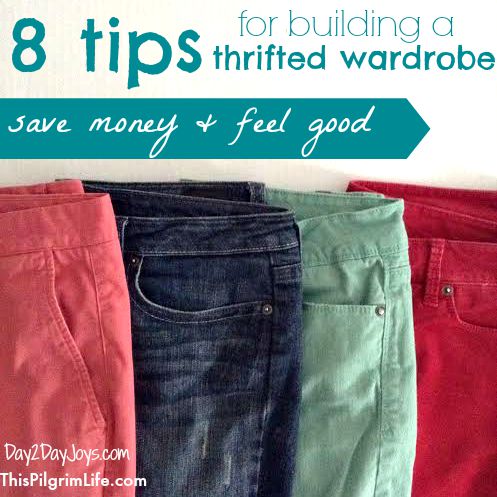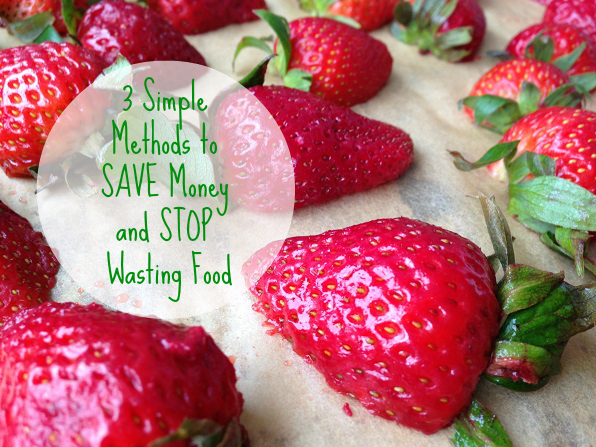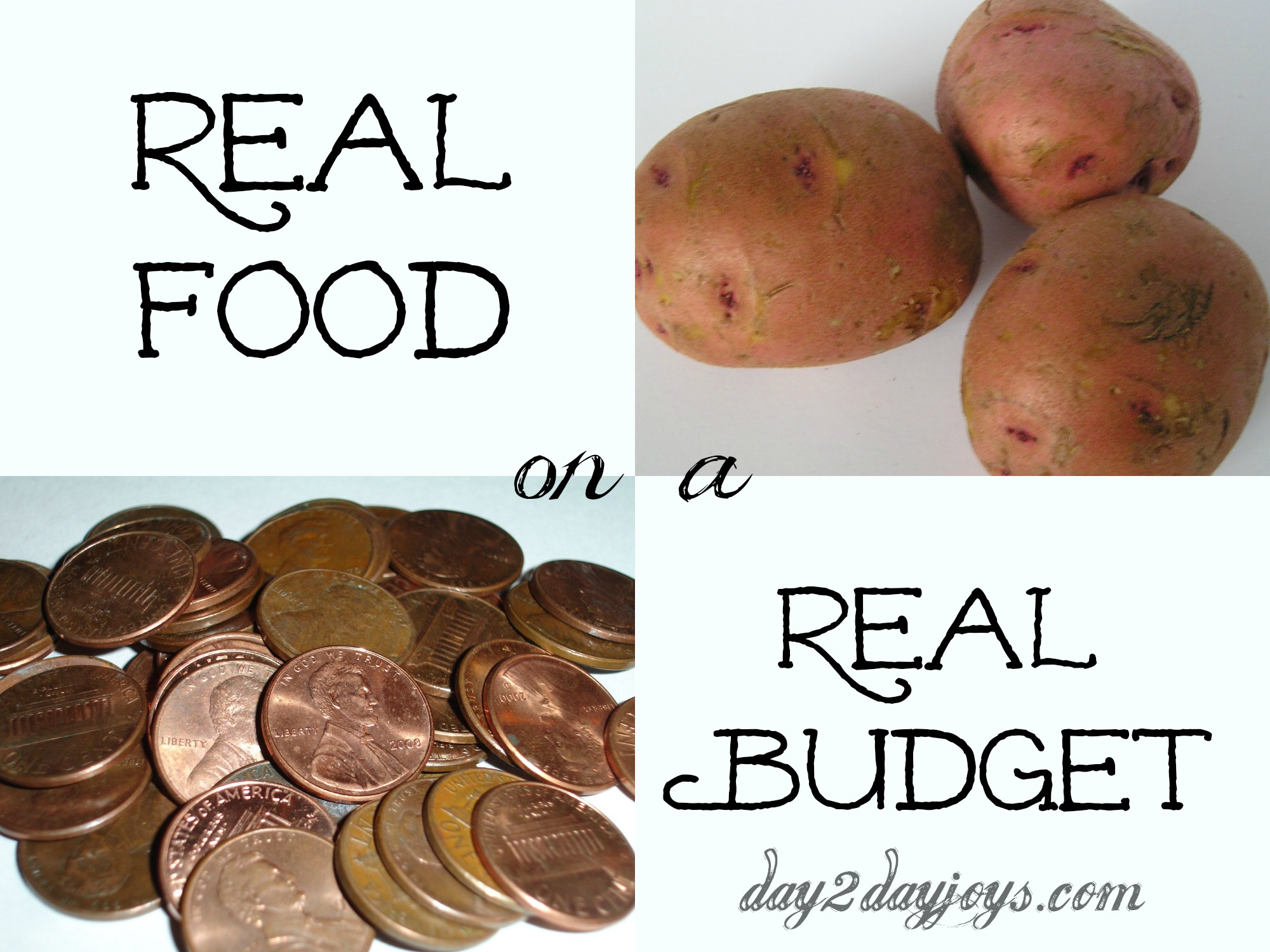The post Meal Planning and Shopping Tips appeared first on Day2Day Joys.
]]>
Written by Karen @ To Work With My Hands, Contributing Writer
Whether you enjoy it or hate it, gathering food and preparing it for our families is something we all have to do.
Sometimes I really enjoy it. At other times…not so much. But, with over 27 years of experience behind me, I’ve learned a few things that have helped make it a natural part of my routine.
It all starts with a plan.
Building The Menu:
Since I shop for groceries every other week, I plan our meals two weeks at a time. Meal planning this way has a few advantages:
- It corresponds with my husband’s pay schedule so I can do all of our shopping, bill paying, and errand running at once.
- When food items are on sale, I can stock up and repeat a menu twice during the menu cycle.
- Shopping every other week instead of weekly really does save on the grocery bill (we tested out the weekly shopping trips once and were stunned at how much more we spent.)
I begin with an Excel spreadsheet with blocks for 21 meals. On each row I list the menu for the first week, type a slash mark, then list the menu for that same day the second week. Often I will just type “x2” beside a meal and we’ll have it both weeks.
Filling in the Menu:
I follow a distinct routine each time I build a new menu. The very first thing I do is transfer meals. Nearly without fail, we will have a meal or two leftover from the previous menu that we never got around to preparing for one reason or another. Because I already have the ingredients on hand, I’m already lowering the next grocery bill.
Next, I shop the pantry, refrigerator, and freezer. If we have leftovers or extras that can be made into new meals, I add those to the menu and note any additional items I’ll need to buy to prepare them.
The next step I take is to shop the sales ads. All of the grocery stores I shop have online ads, which makes it a breeze to browse their sales. I regularly shop 5 different stores for our groceries, snagging the best deals at three of them, and buying the rest that we need at Sam’s Club and Wal-Mart.
I buy nearly all of our produce at one of the stores and the other two offer weekly Buy 1, Get 1 Free sales, which I use to lower our bill for the menu or to stock up on things we use frequently. Armed with sales information, I then use those items to create menu plans.
Finally, if I still have holes in the menu, I go to my old menu folder for ideas from previous weeks that I may have forgotten about.
Making the Shopping Lists:
While checking the sales ads, I jotted down the items I planned to buy. The only remaining lists to make are those for Sam’s Club and Wal-Mart.
As much as I’d like to avoid Wal-Mart, the things that I can’t get elsewhere get purchased there, and we are still a large enough family that shopping at Sam’s Club makes sense.
I keep a master Excel worksheet for each of these stores with a list of the common things we buy.
When I realized we were often buying the same things over and over at Sam’s Club, I created a master sheet. Now, all I have to do is go down the list and decide if we need to purchase each item during the upcoming trip.
I make a list on the side of the items we need, add any additional items, copy and paste it into an email, and send it to my husband or teen son (who almost always does the Sam’s Club shopping for us).
Wal-Mart is my beast! I start with the master list, making note of the basics that we need in each department. After those are typed into my list, I go down the menu, meal by meal, noting any additional items I need to prepare them. These are added to the Wal-Mart list. Sometimes I email it to myself, but often I just print it out because nearly without fail, someone will ask me to pick up _____ while I’m at Wal-Mart and I need to add it to the list.
My Favorite Shopping Habits:
For a couple of years, I tried the coupon game. Eventually, however, I gave it up because it was so time-intensive, and I found that we were actually changing the culture of our eating habits because of them. Now, I will occasionally use them if they are easy, a great deal, and something I would have purchased anyway.
Instead, I prefer to shop for the best deals I can find. During the summer, I visit the farmer’s market and local produce farms to get the freshest produce available and at great prices. For the rest of the year, the practice of pursuing ads and gleaning the best deals has worked much better than trying to pair coupons with my purchases.
Buy 1, Get 1 Free deals are some of the best ways I’ve found to save, and I try to always stock up on things that we use frequently when they are offered in these sales.
My very favorite shopping habit, however, is using shopping apps to save. SavingStar, Ibotta, MobiSave, and Checkout 51 are my favorites. Although they are slightly different, the basic principle with each is to scan the barcodes from purchased items, upload the sales receipt, and get cash back in your account! There are various payout methods for each, but my favorite are those that offer a direct transfer to my PayPal account. Over time it really adds up and is much less time-consuming than dealing with coupons.
Finding unique ways to shop and save is as individual as each family, but with a few basic principles in hand, you’ll be well on your way to a routine that is effective, yet low-impact – even with more than a few mouths to feed.
What are some of your favorite menu planning and shopping tips?
The post Meal Planning and Shopping Tips appeared first on Day2Day Joys.
]]>The post How to Build A Thrifted Wardrobe appeared first on Day2Day Joys.
]]>In high school, it was boys’ t-shirts, size large, which I shopped for at local thrift stores. Colorful shirts from summer camps and elementary school field days, paired with jeans with the hem let out, and flip flops in every color made up my teenage uniform.
In college, I shopped for server black and whites that could be worn again and again during long restaurant shifts, and a starter wardrobe fit for a young student teacher.
These days, my style has changed, but my primary source for supplying my wardrobe has not. Thrift stores have been saving me and my family money for over a decade. And during those ten years I have learned a thing or two about how to build a stylish wardrobe for much less money.
Last week one of my favorite stores sent me a coupon for $10 off any purchase. The coupon was just enough incentive to draw me into the store to check their sales and clearance racks. I am in an awkward in between stage right now with my weight– my maternity clothes are too big and yet I haven’t lost enough weight to fit into my “normal” Fall wardrobe.
I found two or three items from the store that I really liked, but I wasn’t ready to spend the amount on the price tag. Not just yet, anyway. First I wanted to check in my favorite thrift shop for what I needed. Because more often than not, I can find the clothing I need for a fraction of the cost.
As I perused the racks, I gave a lot of thought to this post. What works and what does not. Here’s what I know…
How to Build A Thrifted Wardrobe
1. Go alone if possible.
I have done more than my fair share of shopping with my kids in tow. In fact, most of my Goodwill trips are made all together. But, I know that my kids’ patience runs thin if we are not moving along quickly enough. It is also altogether difficult to try on clothing while wearing your baby or while trying to discourage your toddlers from crawling all over the floor.
If you must go with children, bring along the stroller (see above sentence), and a non-messy snack or two. If I need a little extra patience from my children, I will first go by the section with the children’s books or toys to give them something to look at while we shop. Sometimes we leave with a new toy or book. Sometimes we don’t.
2. Be thorough. Very thorough.
There really isn’t anyway around this one. In order to find quality clothes in the right style and size, you need to look through all the racks, piece by piece.
In a row of two hundred shirts, I may find 3 to 5 to try on. In order to find the ones I want, I have to look through many which I do not.
3. Learn to speed shop.
I have learned how to look search through the hundreds of hangers efficiently over the years. If you take a second to look at every article of clothing, the time really adds up and the process can be rather frustrating.
Instead of pausing to inspect each item, learn to scan the rack with your eyes and with your fingers. In a section of clothing, you can almost immediately eliminate over half of the pieces simply from the pattern or material. Thus, you are only checking the brand and size of a handful of pieces in each row of clothes.
4. Pay attention to brands.
I joke with my husband that I wear nicer clothing since I shop at thrift stores than if I purchased everything new. Every single time I visit a thrift store to look for clothes, I find multiple pieces of clothing from higher end stores like Ann Taylor, Banana Republic, Eddie Bauer, J. Crew, Gap, and so on. Generally speaking, these clothes are often in good condition because they are made from materials that hold up well over time.
Not everything from these stores is in my style or size, but I do give these tags preference. Be familiar with the stores whose quality you appreciate and keep an eye out for those tags.
5. Don’t pay too much attention to brands.
That being said, do not completely exclude the brands with which you are not familiar. More than a few of my favorite pieces of clothing are from brands completely unfamiliar to me.
Just recently, I found a pair of coral colored pants at Goodwill. At first I was not going to try them on because the fit looked a little funny and I did not know the brand. I gave them a chance, though, and they ended being a great fit and good quality too.

The scarf was made in just ten minutes from a jersey knit. Find the quick and easy tutorial here!
6. Only buy what you need. Only buy what you love.
In the past, I have filled my closet with more clothes than I need, excusing the excess because the clothes were purchased frugally. But excess is excess, and owning more clothes than you need does not add any more value to your life or your closet. It simply adds more strain on your space and time.
Using the same excuse of not investing much money, it is also easy to buy clothes which you “mostly like” or which don’t quite fit right but close enough. However, if you don’t love it when you buy it, you are not going to love it simply because you have brought it home.
The same principle applies whether you are buying new or thrifted clothing– buy what fits well, what you feel good in, and what serves a purpose.
7. Inspect each item.
I hate buying a piece of clothing from a thrift store only to discover a hole or stain when I get home. Before you head to the cash register, look over each article of clothing. On shirts and sweaters, give careful attention to the neckline and underarms. On pants, pay attention to the pockets, hem, and waist area.
Occasionally, I will buy something even with a stain or hole because I know it’s just going to be worn around the house, but I want to know about it beforehand just the same.
8. Think outside the box.
If you sew, or know someone who does, many items at a thrift store can be easily repurposed or mended. Dresses can be altered, men’s sweaters or shirts can be repurposed into scarves, skirts or pants can often be taken in or hemmed.
Another occasion to think outside the box is shopping for maternity clothing. At least half of the clothes in my maternity wardrobe were non-maternity pieces which I found at thrift stores. Pants in a few sizes up can work well as your belly grows. Many shirts also accommodate baby bumps, whether they are maternity or not.
If you were wondering, my trip to the thrift store was successful this weekend!
Instead of paying a lot of money for a couple of shirts from the store (even after my coupon and their sales), I found a pair of Gap jeans, a plaid button-up shirt, and a pair of red cords from Ann Taylor. I needed the jeans (again, awkward body stage), the plaid shirt will be a part of my Fall uniform, and I have been looking for red pants for a long time so I was very excited to finally find some in my size!
Do you buy any of your clothes from thrift stores? What are some of your favorite items to shop for?
The post How to Build A Thrifted Wardrobe appeared first on Day2Day Joys.
]]>The post What It’s Like to Afford Fresh Organic Produce and How You Can Do It Too appeared first on Day2Day Joys.
]]>**Please meet Reelika, a new contributor… she would love to hear from you! -Rachel
You are a great mommy. You want the best for your kids and family. It is the hope of many families to be able to provide organic veggies, fruits and berries to their family and especially to the kids. Unfortunately the downside of organic produce is the cost. But what if I told you there are ways that you can still provide the best organic produce to your kiddos without breaking your budget?
As a mom to an allergic toddler and having been diagnosed with hypothyroidism myself, I have done lots of research about the benefits of organic food. I am not a health care advisor, but I can share what has worked for our family and how you can do it too.

Organic produce has been very beneficial for our family. Since my toddler is allergic to many things, I provide him with several organic veggies, fruits and berries. He loves this delicious organic produce and is not a picky eater anymore. He used to be very hyperactive, but since switching to organic food, we don’t seem to have much of a problem with it anymore.
We cut back on other things, but invest into our health, so it keeps us away from pharmacies, doctor’s office and hospitals. Being healthy means also being more productive and happy at preschool, home and work.
Top 3 Tips on How to Afford Organic Produce
Tip # 1 – Organic Produce as an Investment
Don’t look at the price tag of the organic produce as a number; instead, see it as an investment. Compare it to the costs of medications, health care and doctor’s visits.
Chances are you have heard that non-organic food can contain pesticides and cancer-causing hormones or even GMOs. Research shows that pesticides can cause not only cancer, but also allergies, skin and neurological issues, ADHD, birth defects and much more.
Children are especially sensitive to pesticides due to their development and growth. You can either pay the farmer or the pharmaceutical business.
It is time to invest into your and your family’s health. The truth is, many people don’t think about it until they have some kind of health problem. I have to admit, I am completely guilty as I was one of them.
I never felt the need for organic food, until I was diagnosed with hypothyroidism during pregnancy. Since then I have invested into my health instead of the medications I had to use. In fact, medications were more expensive than my investment in organic produce, and I am so much healthier now.

Tip # 2 – Prioritizing Organic Produce
Take a look at what other monthly expenses you have – a new iPhone, expensive jewelry, eating out several times per week, new fancy toys, etc. If you can afford any of them, you can also afford organic produce. Find ways to cut back on monthly payments and use the money instead for quality organic produce.
I am always looking for ways to cut back on our monthly expenses. Saving water and lowering heating costs increases our grocery budget. A monthly budget gives you a crystal-clear overview of your highest expenses so you can make your own choices of where to cut back.
Tip # 3 – Making the Right Choices
It can save you big bucks if you are making the right choices. Be aware of when and which organic produce to buy.
Here is what to keep in mind while choosing fresh organic produce:
- If you bought expensive organic veggies yesterday, then find less expensive produce to buy next time you do groceries. It keeps your budget in balance.
- Meal plan and create a grocery shopping list. Buy the amount of veggies you are planning to eat so you won’t be wasteful.
- Be creative with organic veggies that are close to expiring. You can use them for smoothies, baking, or soup.
- Buy what is on sale or close to its expiry date. It can save huge bucks when the expiration date is close by. Just make sure you use it as soon as possible.
- Buy local. Any organic local veggie is always cheaper than an imported one.
- Prefer seasonal. Prioritize what is in season as it tends to be cheaper, and you can also freeze these for the non-seasonal time.
- Don’t buy pre-washed and packaged food, as these cost much more.
- Prefer healthy veggies and berries for snacks. Leaving chocolate, cookies and chips out of your grocery list saves you money for organic veggies, fruit and berries.
- Frozen organic veggies are great choices as well. Buy them in bulk and while on sale.
- Grow your own organic herbs that you can use for meals. You don’t need a yard to grow your own green leafs. All you need is a small space in kitchen or on a balcony to have your own organic herb section. I also have mini-tomatoes growing in my kitchen.
- Wash the produce just before using it so it will last longer.
- Citrus produce can last at least a week longer when stored in the fridge.
- Don’t forget coupons! Find the best deals and use them.
- Negotiate if possible. When buying directly from a farmer, use your negotiation skills. Offer to buy in bulk and don’t be afraid to ask for a discount. Most likely the farmer will be more than happy to offer you a discounted price when selling more. You can freeze the extra for later and will have saved big bucks.

Fresh organic veggies, fruits and berries are always going to be expensive, but investing into our family’s health and cutting back on our monthly expenses has made a difference for our well-being. Making the right choices keeps us on budget and provides a quality lifestyle. You can do it too!
Did I miss anything? How do you make organic produce affordable for your family?
The post What It’s Like to Afford Fresh Organic Produce and How You Can Do It Too appeared first on Day2Day Joys.
]]>The post The Ultimate Homemaking Bundle {Worth $898 for Less than $30} appeared first on Day2Day Joys.
]]>
By popular demand, 100+ homemaking bloggers are bringing back The Ultimate Homemaking Bundle, and it’s better than ever!
The Ultimate Homemaking Bundle is a complete library of great eBooks on homemaking—a truly valuable knowledge base you’ll use for many years to come.
Unlike a library, though, you don’t have to spend years building it up. The Ultimate Bundles team has done the hard work for you, searching the web to find the very best eBooks from top homemaking authors and combining them into one essential collection that you can buy in one simple purchase.
Act now to get the ultimate eBook collection on homemaking at a once-in-a-lifetime price.
With a Risk Free 15 Day Guarantee!
I’m confident you won’t find a more comprehensive set of homemaking resources anywhere — and certainly not at this price. Bought separately, they’d cost a total of $698 (not including $200+ in bonuses!). But you can have all of them for just $29.97!
Or, for just an extra $10, you not only get the full set of PDF files, but also a bonus set of Kindle editions, perfectly formatted for easy Kindle reading. This has been a popular request over the years and I’m excited to say it’s now available!
I believe it’s the best deal on homemaking eBooks anywhere on the web. But it will only be available for six days. So grab yours before it’s gone!
This huge wealth of information and guidance will be right there on your laptop, tablet, smartphone, or Kindle, whenever you need it.
Here’s what you need to know about the sale:
When? 8 a.m. EST Wednesday, April 23 until 11:59 p.m. EST Monday, April 28
What? 78 eBooks, 2 eCourses, 2 audio files, and 2 printable packs PLUS over $200 worth of bonus products you’ll really use!
Where? Purchase the bundle here.
How much? Well now, that’s the best part. The entire package is worth nearly $900, and it’s selling for less than $30. Sweet deal, right?

What’s in the Ultimate Homemaking Bundle? ($698 value!)
Homemaking
- DIY Natural Household Cleaners: How To Make Your Own Cleaners…Naturally by Matt & Betsy @ DIY Natural ($9.99)
- Filling Hearts While Cleaning Homes: Five Minute Devotions for Families by Jenn Thorson & Lindsey Stomberg ($8.00)
- Hospitality: The Duty of the Christian Home by Kathy @ Teaching Good Things ($4.97)
- How to Build a Strong Christian Home by June @ A Wise Woman Builds Her Home ($4.99)
- Life Your Way Printables Download Pack by Mandi @ Life Your Way ($7.00)
- Sewing School 101: Simple Tips to Get You Stitching by Nicole @ Gidget Goes Home ($11.99)
- Taming the Laundry Monster by Angi @ SchneiderPeeps ($3.99)
- The Best of Visionary Womanhood: Volume Two by Natalie @ Visionary Womanhood ($4.99)
- The Homemaker’s Guide to Creating the Perfect Schedule by Amy @ Raising Arrows ($4.99)
Food
- Bliss Balls for Beginners: 21 Recipes to Get You Started by Luschka @ Keeper of the Kitchen ($3.50)
- Dairy Free 101 by Becky @ For This Season ($5.00)
- Just Making Ice Cream: Over 70 Delicious Recipes Made with Nourishing Ingredients – 2nd edition by Marillyn @ Just Making Noise ($12.00)
- Happy Mom, Healthy Family Meal Planning Workshop + Cookbook by Lisa @ WellGroundedLife ($29.00)
- Meal Planning Made Easy by Kelly @ The Nourishing Home ($6.99)
- No Cook Freezer Meals by Kelly @ New Leaf Wellness ($5.99)
- Simplified Dinners by Mystie @ Simplified Pantry Cooking ($12.99)
- The ABC’s of Freezer Cooking by K.M. @ KMLogan.com ($2.99)
- The Healthy Lunch Box: Sandwich-Free Secrets to Packing a Real Food Lunch by Katie @ Kitchen Stewardship ($9.95)
- The Sweeter Side of Candida: Desserts for the Holidays, Special Occasions, & Everyday Sweet Treats by Paula Miller & Sarah Ives ($14.95)
- {Healthy} Make-Ahead Meals & Snacks by Laura @ Heavenly Homemakers ($5.00)
- Real Food on a Real Budget: How to Eat Healthy for Less by Stephanie @ Keeper of the Home ($18.97)
- Simple Cooking to Save You Money by Kelly @ Generation Cedar ($4.97)
- The Frugal Secrets of Real Foodies by Shannon Miles, Sarah Nichols, Kristen Smith, Kate Tietje, and Katherine (Katie Mae) Stanley ($9.97)
Motherhood
- Discipleship & Discipline: Practical Parenting Help for the Desperate Mom eCourse by Sally Clarkson and Sarah Mae ($17.99)
- Pieces of Mommy: Putting Yourself Back Together by Sarah @ SarahStrausbaugh.com ($7.99)
- Steady Days: A Journey Toward Intentional, Professional Motherhood by Jamie @ Steady Mom ($9.55)
- The Cherished Home: Protecting What’s Important by Mary @ The Encouraging Home ($14.99)
- The Pursuit of Motherhood by Caroline Allen, Jennifer Allen, Mary Clendenin, Kelly Crawford, Jasmine Cucuta, Sara Elizabeth Dunn, Jacqueline Fitzgerald, June Fuentes, Heather Knopp, Melinda Martin, Richele McFarlin, Melanie Moore, Amy Roberts, Lindsey Stomberg, Jacinda Vandenberg, and Melanie Young. ($7.99)
- Undivided Mom: Finding Christ in the Chaos of Motherhood by Kayse @ KaysePratt.com ($4.99)
Marriage
- 31 Days to Build a Better Spouse by Ashley @ LIFE by Ashley Pichea ($7.99)
- Dear Wife: Letters from a Help Meet by Misty @ Beautiful Ashes ($2.99)
- Intentional Marriage: The Art of Loving Your Husband (A 31 Day Devotional) by Crystal @ Serving Joyfully ($3.99)
- The Ultimate Marriage Vow: 21 Days of a Life-Long Commitment by Darlene @ Time-Warp Wife ($2.99)
- To Love, Honor and Vacuum Audio Download by Sheila @ To Love, Honor and Vacuum ($2.99)
Faith
- A Heart Prepared: A Simple & Effective Scripture Memory System by Jami @ Young Wife’s Guide ($9.95)
- How To Manage Your Mouth: A 30 Day Wholesome Talk Challenge by Connie @ Smockity Frocks ($5.97)
- Restoring the Lost Petal: A Journey Through the Loss and Restoration of Sexual Purity by Danielle @ More Than Four Walls ($8.99)
- Set Apart: Becoming a Woman of Virtue in a Modern World by Anjanette Barr, Whitney Cornelison, Jennifer Fountain, Virginia George, Crystal Hatcher, Sarah Nichols, Rachel Marie, Ashley Roe, Kendra Stamy, Danielle Tate, and Karli Von Herbulis ($3.99)
- The Homesteading Wife’s Christian Devotional: Finding Biblical Truths on the Farm by Susie @ Our Simple Farm ($3.99)
Faith {For Kids}
- Be Thankful: Cultivating Year-Round Thankfulness by Amanda @ The Pelsers ($7.99)
- Character Badges by Caroline @ The Modest Mom Blog ($9.99)
- God Gifted Virtues by Sara @ Your Thriving Family ($8.95)
- Learning to Speak Life: Fruit of the Spirit Family Devotional by Michael & Carlie @ Learning to Speak Life ($9.99)
- The ABC’s for Godly Boys/The ABC’s for Godly Girls by Lindsey @ The Road To 31 ($19.98)
- The Warrior Weekend: Helping Dads Raise Boys to Be Godly Men by Patrick & Ruth @ For the Family ($4.99)
Financial Stewardship
- 5 Days to Budget Breakthrough: Change Your Money – Change Your Life by Kimberlee @ The Peaceful Mom ($5.95)
- 76 Free Things to Do with Kids: A Real Mom’s Guide by Shannon @ Growing Slower ($5.97)
- Advanced Penny Pinching: Stockpile – Strategize – Save by Tabitha @ Meet Penny ($3.99)
- Cash Flow Your College: Knowledge in Your Head Without Getting in the Red by Kayla @ Renown and Crowned ($2.99)
- Christian Wealth Building by Michael @ MichaelPink.com ($77.00)
- It’s Me or the Coupons: How a Busy Mom Can Win the Grocery Budget Battle by Beth @ Eat Better Spend Less ($10.00)
Health & Wellness
- Healing With God’s Earthly Gifts: Natural and Herbal Remedies by Kate @ Modern Alternative Mama ($7.95)
- My Simple Healthy Life: A Minimalist Approach to Herbal Remedies, Beauty & Natural Cleaning by Tammie @ Simple. Healthy. Tasty. ($5.95)
- Simple Natural Health: Wellness Made Easy by Nina @ Shalom Mama ($10.00)
Holidays & Special Events
- 100 Days of a New Year 2014 eBook by Jennifer @ ListPlanIt.com ($8.00)
- Christmas Printables for Kids by Kristy @ Little Natural Cottage ($2.50)
- Feast! Real Food, Reflections, and Simple Living for the Christian Year by Daniel & Haley @ Carrots for Michaelmas ($7.99)
- More Than a Holiday: A 25-Day Christmas Devotional for the Whole Family by Scott and Sarah @ Simple Life Abundant Life ($7.95)
- More Than Candy: A 25-Day Christmas Countdown that Counts by Sarah Mae @ SarahMae.com ($4.99)
Homeschooling
- 101 Independent Activities for Toddlers and Preschoolers by MaryEllen @ Imperfect Homemaker ($4.99)
- 1777 New England Primer Cursive/Manuscript Printable Alphabet Sets by Jacinda @ Growing Home ($5.98)
- A Simple Homeschool Planner by Tsh @ The Art of Simple ($4.00)
- The Charlotte Mason Way Explained by Dollie @ Teachers of Good Things ($7.99)
- The Preschool Journey by Angela @ Teaching Mama ($6.99)
- Weekly Homeschool Planner by Jolanthe @ Homeschool Creations ($20.00)
- You Can Read by Carisa @ 1+1+1=1 ($10.00)
- Write Through the Bible: Exodus 20 (KJV, Manuscript) by Trisha @ Intoxicated on Life ($5.00)
Pregnancy & Babies
- Baby Ready: Preparing For and Adapting to Life with Baby by Monica @ Happy and Blessed Home ($7.99)
- Breastfeeding Twins, Triplets and More! by Jennifer @ Growing Up Triplets ($10.00)
- Cloth Diapers: A How-To Handbook on the Basics of Cloth Diapering by Rachel @ Intentionally Simple ($5.99)
- The Breastfeeding Lifeline: A Guide to Navigating the Newborn Days by the authors at Breastfeeding Place: Anjanette Barr, Michelle Ferguson, Jennifer Fountain, Trisha Gilkerson, Sarah Harkins, Shary Lopez, Kristen Smith, and Rhiana Wackenhuth. ($5.95)
- The Minimalist Mom’s Guide to Baby’s First Year by Rachel @ The Minimalist Mom ($4.99)
- Topical Devotions for Pregnancy: 13 Devotions to Nourish Your Soul by Becky @ Purposeful Homemaking ($3.99)
Self-Care
- 21 Days to a More Disciplined Life by Crystal @ Money Saving Mom ($4.99)
- Equipped: Because You’ve Been Made to Live On Purpose by Elisa @ More to Be ($6.99)
- Live for Him: A Grace-Filled Look at Planning by Leigh Ann @ Intentional By Grace ($2.99)
- The Busy Homeschool Mom’s Guide to Daylight: Managing Your Days Through the Homeschool Years by Heidi @ The Busy Mom ($10.00)
- Your Retreat: A Guide to Giving Yourself a Personal Planning Day by Erin @ The Humbled Homemaker
Working from Home & Blogging
- Blog Planner 2014 by Sarah @ My Joy-Filled Life ($4.99)
- Blog at Home Mom: Balancing Blogging and Motherhood by Christin @ Joyful Mothering ($4.99)
- FaithLeaps: The Christian Mom’s Guide to Passion, Purpose, and Profits by Alyssa @ AlyssaAvant.com ($4.99)
- Monkey See, Monkey Do: A Tutorial to Using PicMonkey with Professional Results by Richele @ Under the Golden Apple Tree ($8.00)
- The Blog Planning Kit: A System to Maximize Your Blogging Efforts by Kat @ How They Blog ($15.00)
What are the Ultimate Homemaking Bonus Offers? ($200+ value)
In addition to all the amazing eResources, this bundle includes the best bonus offers it’s ever had. These deals are worth over six times the price of the Ultimate Homemaking Bundle. So you’re up on the deal right away!
- DaySpring—A FREE 10-pack of Premium Greeting Cards. ($20.00 Value. Standard shipping applies.)
- HopeInk—$15 HopeInk store credit to be used towards anything + a FREE 8×10 Art Print with order. ($39.00 Value. Standard shipping applies.)
- Redeeming Beauty Mineral Makeup—3 FREE eyeshadows of your choice from Redeeming Beauty. ($16.47 Value. Standard shipping applies – only ships to US and Canada.)
- Marie-Madeline Studio—A $15 store credit for anything in Marie-Madeline Studio’s online store. ($15.00 value. Standard shipping applies.)
- Once a Month Meals—A FREE One Month Pro Membership from Once a Month Meals. ($16.00 Value. No shipping required.)
- Dizolve—FREE 64-load pack of Dizolve Laundry Strips for you PLUS a Free 64-load pack of Dizolve Laundry Strips for food banks. ($25.98 value. Standard shipping [$3] applies. Only ships in the US.)
- TrilLight Health—Get a FREE 2 oz. bottle of a liquid health formula OR $15 store credit from Trilight Health. ($15.00 Value. Standard shipping rates apply.)
- ListPlanIt—Free 3-month membership OR 3 free ePlanners from ListPlanIt. ($15.00 value. No shipping required.)
- Bulk Herb Store—Instant download of the instructional video Making Herbs Simple Volume 2 for FREE from Bulk Herb Store. (up to a $15.00 Value. No shipping required.)
- Fit2B
 Studio—FREE 2-Month Online Fitness Membership at Fit2B
Studio—FREE 2-Month Online Fitness Membership at Fit2B Studio. (up to a $20.00 Value. No shipping required.)
Studio. (up to a $20.00 Value. No shipping required.)
Remember, this bundle is available for 6 days only, from 8 a.m. (EST) on Wednesday, April 23 to 11:59 p.m. (EST) on Monday, April 28th.
Disclosure: I have included affiliate links in this post. Read the fine print about this bundle and read the answers to frequently asked questions about the bundle.
The post The Ultimate Homemaking Bundle {Worth $898 for Less than $30} appeared first on Day2Day Joys.
]]>The post Real Food on a Real Budget appeared first on Day2Day Joys.
]]>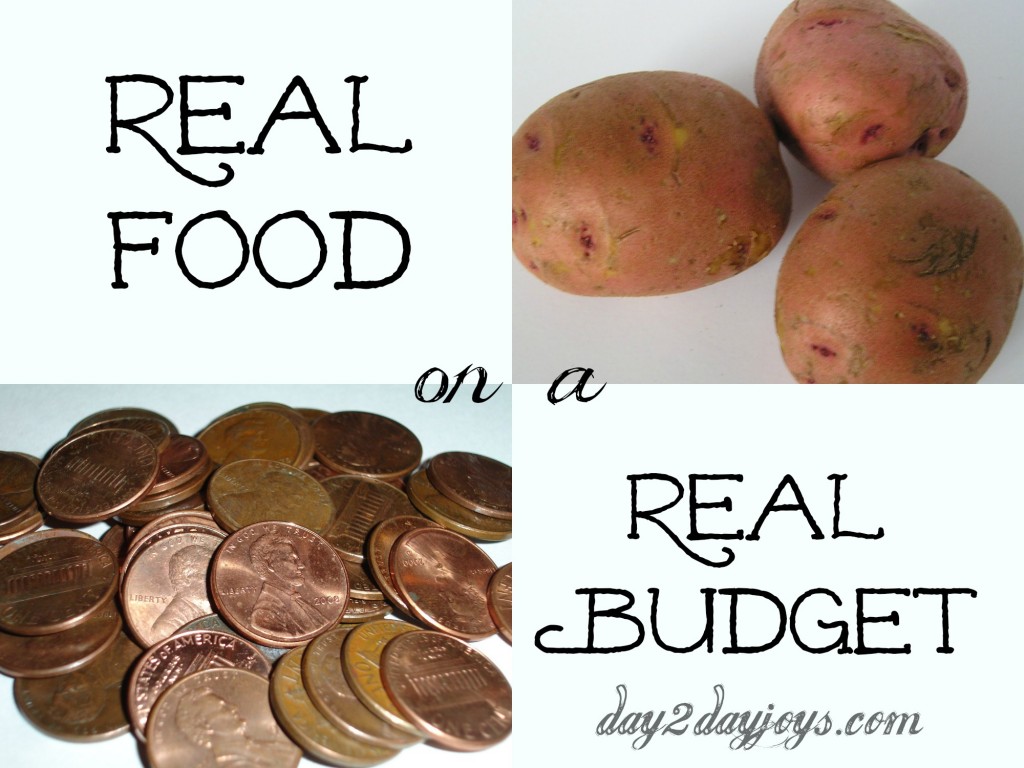
Written by Kristen @ Smithspirations, Contributing Writer
With it being January, you may very well be trying to cut out the processed foods in your diet and take a more whole foods approach to eating. I don’t think anyone denies that eating well is a great way to boost health, but often finances get in the way of making positive changes. Does eating real, whole, healthy foods have to break the bank?
I’m convinced that it doesn’t!
Our family lives on a moderate income. My husband is a public school teacher, and while his salary is far from glamorous, it pays the bills. We have a little bit of supplemental income from a few sources, like my home business, but with our growing family of five children, we have to watch our budget in all areas.
By God’s grace, I’ve found various ways to keep our plates healthy while still keeping our budget in check.
This post contains affiliate links. Purchases made through these links come at no additional cost to you but can bless our family with a small commission. Thank you!
Buy In Bulk
Many foods are suitable for buying in bulk and then storing, drying, canning, or freezing for later.
Berries can be frozen, greens and herbs can be dehydrated, and tomatoes and other fruits can be canned. While the initial cost is a little intimidating, buying a quarter, half, or whole animal for freezer meat is much less expensive per pound, and you can also get more bones for making and freezing broth!
Now that we have a grain mill, I buy our grains for flour in large 25 or 50 pound bags and usually get them for 50 cents to a little over a dollar a pound, depending on the type.
Shop Your Backyard
Gardening can be intimidating, but as long as you approach it with some grace, it can be a wonderful way to cut back on your grocery bill! You’d also be surprised by how many backyard “weeds” are actually very nutritious foods! My children can often be found munching on purslane, sorrel, and chickweed from our yard when we are outside, and I sneak them into salads and cooking, too.
Eat What’s Local
Sometimes it’s easy to get caught up in the latest super foods that have to be purchased from expensive specialty stores. But real food can also be really common food that is easy to find. Check local farmers’ markets during the growing seasons and focus on what is abundant and inexpensive. In the winter time, turn your attention to frugal foods like winter squash, carrots, and the humble potato.
Roll Up Your Sleeves
Packaged and convenience food is always more expensive. A bag of frozen french fries costs more than a bag of potatoes. Doing more of the prep work yourself is a fantastic way to save money even if it does require a little more effort. Enlist your children if they are old enough and share the labor while making fun memories together!
Shop Online
Sometimes one of the best ways to save money is to shop online. Foods that don’t spoil easily, like pastas, rice, and beans can be found online at great discounts! Amazon has a huge grocery selection. For example, I get my organic coffee from Amazon with Subscribe & Save. It ships for free, and I get a discount on the price. Win!
Vitacost is another site I like to check when I’m shopping for foods or household items. (If you’re a first-time customer, you can get $10 off with this link!)
Stretch Meat With Beans and Lentils
Meat is definitely one of the priciest items in our grocery budget, but I believe it is really important to our health! I often make meat stretch a little farther by adding cooked beans or lentils to ground beef and using a whole pound of dried beans with a 3 pound roast to make a bulk batch of taco filling.
Now it’s your turn! What are your best tips to help save money while eating real, healthy food?
The post Real Food on a Real Budget appeared first on Day2Day Joys.
]]>The post Real Food on a Budget appeared first on Day2Day Joys.
]]>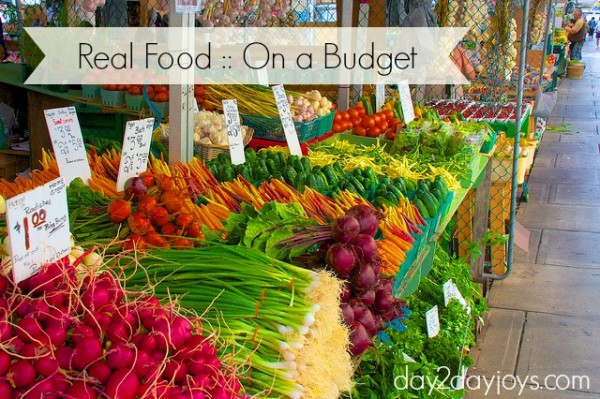
Written by Jenn @ A Simple Haven, Contributing Writer
Anyone else ringing in the New Year with some kind of detox? After consuming more sugar and white flour in the past several weeks than I have during the rest of the year, my body is crying out for fruits and veggies.
Even if you’re not doing anything drastic, maybe you just want make better food choices in 2014–avoid processed stuff, replace some conventionally-grown produce with organic, eat more locally-grown stuff (good luck in January, right?), or just be mindful of how certain foods make you feel.
However, if you’ve started down the road to eating mostly “real food,” you’ve probably noticed it’s easy spend waaay more than usual on groceries.
The reality is quality food costs more than junk. It’s a bummer, but it’s true. And, in many ways, it makes sense.
Is that to say you’ll have to dole out hundreds more to eat well? Not necessarily.
In my experience, it is possible to eat real food while sticking to a reasonable grocery budget. It just takes a little planning and strategy.
9 Tips for Eating Real Food on a Budget
1.) Meal plan. Just do it
Seriously, it’s the easiest way to mind your costs. Make a list of favorite meals, write down the ingredients needed, and stick to that list at the store.
Though I’ve never tried it, I’ve heard Plan to Eat is great. You enter your favorite recipes and it produces your grocery lists. Sounds simple and there’s a free 30-day trial.
2.) Be strategic
As you plan, be mindful of spreading out more expensive items over multiple meals. For example, roast a whole chicken on Monday, then use it later that week (or month, if you freeze it) for chicken pot pie, chicken enchiladas, chicken soup, etc.
3.) While we’re talking chicken, buy whole chickens
It’s so much less expensive per pound than breasts and even if you’re not a dark meat fan, in soups, casseroles, and the like, you probably won’t notice it’s not white.
Not a meat eater? Great! Beans are cheap! 
Seriously, though, a few hearty vegetarian meals in the rotation will help the budget loads.
4.) Buy in bulk
Whether it’s from a co-op, Costco, or the bulk isle at your local grocery, bulk almost always equals better prices. Some co-ops I’m a fan of are Azure Standard and Frontier–and, if you’re in the Midwest, Country Life Natural Foods.
Buying a whole or portion of a cow is also super cost-effective. Check out this site for options near you.
5.) Start a co-op
No Azure Standard drop-offs in your town? You can start one if you can get enough families ordering.
No room for 25 pounds of almond flour? Find some friends or neighbors to split.
No raw cheddar cheese available locally? You can found a cheese club that buys in bulk from an Amish farm in Pennsylvania. Not that I’m in a cheese club or anything…
6.) Price it out
As in, figure out the price per ounce. Tedious, perhaps, but the only way to know if you’re getting the best deal.
If, like me, you’re not math-minded, it can be hard to tell if that gigantic box of whatever at Costco really is cheaper than a single item at your grocery store. And while co-ops generally offer great prices, they don’t always offer the best price.
Plus, if you price it out and make an awesome spreadsheet of your findings, you’ll end up unintentionally memorizing fun facts like coconut oil is 29 cents per ounce at Costco.
7.) Start a garden
Unhelpful in January, but awesome come July. There is nothing like heading to the backyard and coming back with a gigantic dinner salad.
8.) Learn from others
Real foodie folks in your neck of the woods (who are budget-conscious) will often know of local deals or might be willing to split bulk items with you. I’ve also found nutritionally like-minded friends and blogs super helpful in sourcing real-food recipes and budget tips.
Other favorite resources are Plan it, Don’t Panic and Real Food on a Real Budget.
9.) Give yourself a break, prioritize, and be realistic
If you’re on a budget, you simply can’t do it all. So relax, decide what’s most important, and don’t worry about the rest.
Maybe you can cut back in other areas to increase your food spending a little. Maybe you don’t eat every single thing local or organic.
Maybe you prioritize quality meats and dairy and do what you can with produce.
What are your best tips for eating real food on a budget? I’d love to hear.
Especially since I’m apparently only eating quality meat and produce in January. 
The post Real Food on a Budget appeared first on Day2Day Joys.
]]>





